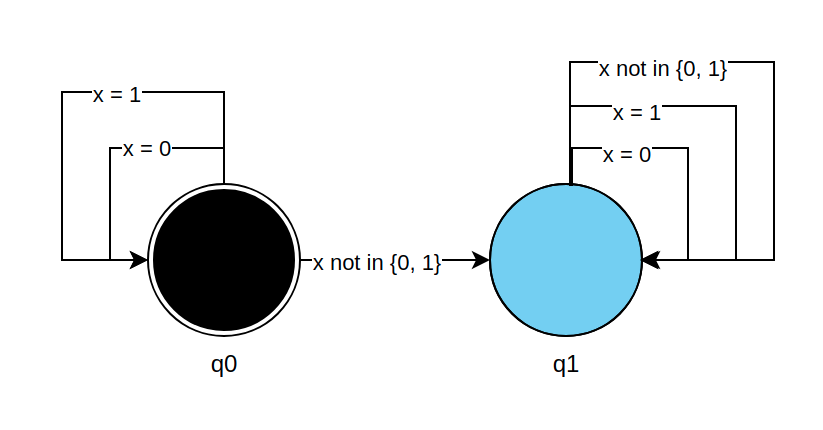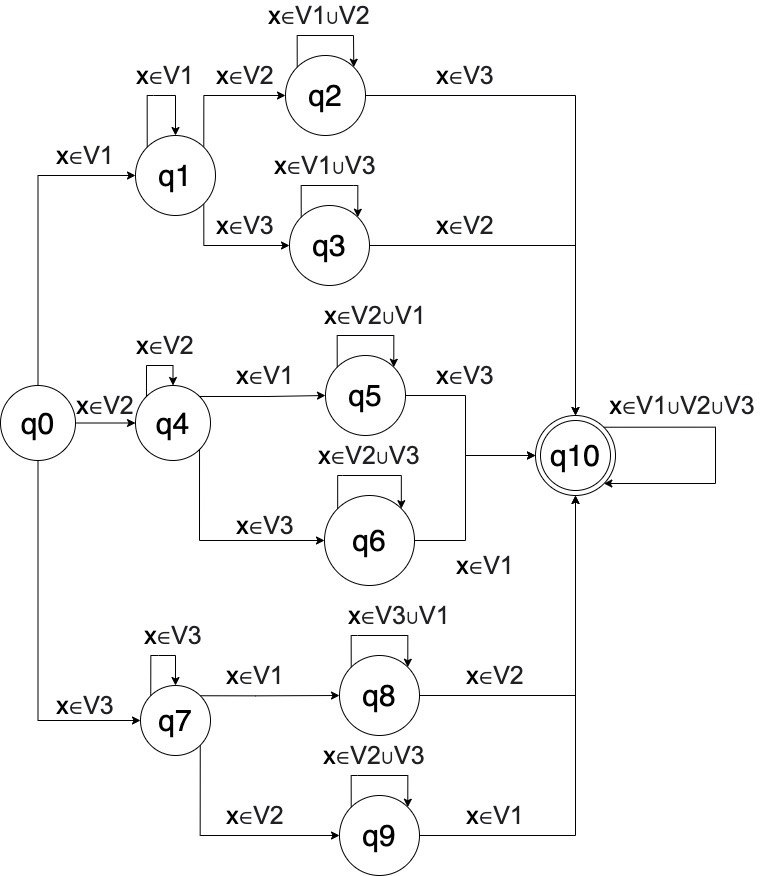A finite-state machine (FSM) is a mathematical model of computation. It is an abstract machine that can be in exactly one of a finite number of states at any given time. The FSM can change from one state to another in response to some inputs; the change from one state to another is called a transition. An FSM is defined by a list of its states, its initial state, and the inputs that trigger each transition.
Mathematically, a FMS can be represented as A = (V, Q, S, F, d):
- V is a input alphabet (a finite non-empty set of symbols);
- Q is a finite non-empty set of states;
- S is an initial state, an element of V;
- F is the set of final states, a (possibly empty) subset of V;
- d is the state-transition function;
Small example. We want to describe FSM for validation binary code (empty string is valid). Then we have:
- V is any symbol;
- Q = {q0, q1};
- S = q0;
- F = q0;
- d:
- d(q0, 0) = q0;
- d(q0, 1) = q0;
- d(q0, x not in {0, 1}) = q1;
- d(q1, 0) = q1;
- d(q1, 1) = q1;
- d(q1, x not in {0, 1}) = q1;
And diagram:

Code example
Now, we try to implement FSM for next task: validating string, which must have lowercase letter, number and special character: !@#$%^&*(). First, formilize our task!
- V = V1 + V2 + V3;
- V1 = {a - z};
- V2 = {0 - 9};
- V3 = { !@#$%^&*() };
- Q = {q0 - q10};
- S = q0;
- F = q10;
Use diagram for transition:

Let’s program our state machine:
#include <string>
#include <set>
#include <map>
using namespace std;
template <typename State>
class FSM
{
private:
const set<char> &alphabet;
const set<State> &states;
State curr_state;
const set<State> &target_state;
const map<State, map<char, State>> &transitions;
public:
explicit FSM(const set<char> &alphabet,
const set<State> &states,
State start_state,
const set<State> &target_state,
const map<State, map<char, State>> &transitions)
: alphabet(alphabet)
, states(states)
, curr_state(start_state)
, target_state(target_state)
, transitions(transitions) {}
bool Test(const string &str)
{
for (const auto &c : str)
{
BelongAlphabet(c);
ChangeState(c);
}
return target_state.find(curr_state) != end(target_state);
}
private:
void ChangeState(const char &c)
{
try
{
curr_state = transitions.at(curr_state).at(c);
}
catch (exception &e)
{
throw invalid_argument("Not transition!!!");
}
}
void BelongAlphabet(const char &c)
{
if (alphabet.find(c) == end(alphabet))
{
throw invalid_argument("Unknown symbol!!!");
}
}
};
But the most difficult job is to describe the data for constructing the FSM. Let’s do it:
set<char> set_union(const set<char> &V1,
const set<char> &V2,
const set<char> &V3)
{
set<char> result(V1);
result.insert(begin(V2), end(V2));
result.insert(begin(V3), end(V3));
return result;
}
enum State
{
START_STATE, Q1, Q2, Q3, Q4, Q5, Q6, Q7, Q8, Q9, VALID
};
const set<char> V1 = {'a', 'b', 'c', 'd', 'e', 'f', 'g', 'h', 'i',
'j', 'k', 'l', 'm', 'n', 'o', 'p', 'q', 'r',
's', 't', 'u', 'v', 'w', 'x', 'y', 'z'};
const set<char> V2 = {'0', '1', '2', '3', '4', '5', '6', '7', '8', '9'};
const set<char> V3 = {'!', '@', '#', '$', '%', '^', '&', '*', '(', ')'};
const set<char> V = set_union(V1, V2, V3);
map<char, State> create_transitions(State s1, State s2, State s3)
{
{
map<char, State> result;
for (const auto &c : V1)
{
result.insert({c, s1});
}
for (const auto &c : V2)
{
result.insert({c, s2});
}
for (const auto &c : V3)
{
result.insert({c, s3});
}
return result;
}
}
const set<State> Q = {START_STATE, Q1, Q2, Q3, Q4, Q5, Q6, Q7, Q8, Q9, VALID};
const State S = START_STATE;
const set<State> F = {VALID};
const map<State, map<char, State>> d = {
{START_STATE, create_transitions(Q1, Q4, Q7)},
{Q1, create_transitions(Q1, Q2, Q3)},
{Q2, create_transitions(Q2, Q2, VALID)},
{Q3, create_transitions(Q3, VALID, Q3)},
{Q4, create_transitions(Q5, Q4, Q6)},
{Q5, create_transitions(Q5, Q5, VALID)},
{Q6, create_transitions(VALID, Q6, Q6)},
{Q7, create_transitions(Q8, Q9, Q7)},
{Q8, create_transitions(Q8, VALID, Q8)},
{Q9, create_transitions(VALID, Q9, Q9)},
{VALID, create_transitions(VALID, VALID, VALID)}};
And last, run it:
int main(int argc, char *argv[])
{
if (argc == 1)
{
cerr << "Not arguments" << endl;
exit(1);
}
string in = argv[1];
FSM<State> fsm(V, Q, S, F, d);
try
{
cout << fsm.Test(in) << endl;
}
catch (exception &e)
{
cout << false << endl;
}
return 0;
}
All code is here!
Of course, for such a small task, using a finite state machine is an overhead, but this is a good example for understanding how to work with them.